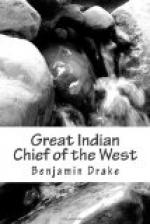In the autumn of 1837, deputations from several Indian tribes, residing upon the waters of the upper Mississippi, were invited to Washington city, by direction of the President of the United States. Among those represented were the united Sac and Fox tribe, and their ancient enemy the Sioux, between whom hostilities were then raging. For the purpose of effecting a peace between them, and also making a purchase of land of the Sioux, several councils were held under the direction of the Secretary at War, but without accomplishing the object in either case. Black Hawk, was connected with the delegation from the Sacs and Foxes, but not in the character of a delegate or chief. Keokuk, apprehensive, that if left at home, the old man might create some new difficulty, had prudently taken him along. He treated him, uniformly, with great respect, and invited him to sit with them in the councils.
After leaving Washington the delegation visited the principal eastern cities, and Black Hawk again attracted much attention. Public curiosity was still alive to see the renowned but fallen chieftain of the famous Black Hawk war. In Boston, which place he did not visit on his former tour, he was waited upon by a great concourse of citizens, and in common with the rest of the delegation, was publicly presented with some military weapons by the governor of the state, and made a brief speech upon the occasion.
Before the return of the deputation to the west, they remained a few hours in Cincinnati. Keokuk was sick and received but few visitors. “Which is Black Hawk,” was the eager inquiry of almost every individual who succeeded in threading his way through the crowd, to the cabin of the steam boat. The old man manifested no interest in the passing scene. He was not inclined to conversation, but sat moody and silent, with an expression of countenance strongly indicative of wounded pride and disappointed ambition. He seemed to feel deeply the degradation of his situation. Shorn of power among his people, compelled to acknowledge the authority of his rival, and bending beneath the infirmities of age, it is not singular that he should shrink from the prying gaze of curiosity, and sigh for the deep seclusion of his wild hunting grounds.
In height Black Hawk is about five feet ten inches, with broad shoulders, but limbs not very muscular. His nose is sharp and slightly aquiline, and his eyes are of a dark hazel color. The most striking peculiarity in his personal appearance is the head, which is singularly formed, and has been pronounced, by some observers, the envy of phrenologists. His countenance is mild and benevolent, having little if any of that dark and ferocious expression, not uncommon among the Indians; and which, during the late border war, was imagined to be eminently characteristic of Black Hawk. In tracing his history, few, if any incidents can be found, which bear out the charge of savage cruelty that has sometimes been preferred




